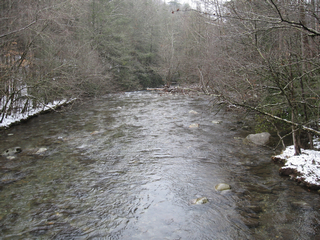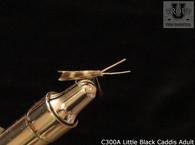Sunshine vs. Overcast
Both trout and aquatic insects tend to be more active in low light, and cloudy conditions spread these light conditions over a longer part of the day. This behavior reflects one of the most basic generalizations about weather and that is that clouds are an angler's best friend. Both trout and aquatic insects tend to be more active in low light, and cloudy conditions spread these light conditions over a longer part of the day. The fish are afforded better protection from aerial predators in low light, making them feed more confidently in the clear waters of a trout stream or tailwaters. In addition, the eyes of trout are capable of relatively rapid adjustment to changes in light intensity, so they have an advantage over their prey in low light. (For a very informative account of the senses of gamefish, see Through the Fish's Eye by Mark Sosin & John Clark.)
The timing and density of hatches also favors the angler on overcast days. On warm, bright days, hatch activity usually starts earlier in the day but will be shorter in duration, often producing brief but very intense activity. Conversely, on cloudy days, hatches show a later onset, but will produce steady numbers of bugs for a longer period of time. This information is key for an angler planning the day's tactics based on weather conditions.
Longer hatches give the angler a better opportunity to make some mistakes and still have a chance to catch a good number of fish. During very intense hatches, the angler sometimes struggles to get his fly noticed among a raft of naturals. The time taken to change flies or untangle a leader may also burn up a large portion of the trout's feeding activity. The wings of mayfly duns dry more slowly in the cooler air temperatures and higher humidity of an overcast day. The result is an emerging insect that stays on the water longer, making them more vulnerable to the fish — this often allows the angler to switch to more visible dun patterns, rather than relying on emergers through most of the hatch.
The one advantage to bright conditions is that it makes spotting fish below the surface much easier. Of course, in many cases, hatches will be heavy enough on cloudy days that spotting fish will be no more difficult than looking for rise forms.
Rain and Snow
Precipitation can have a positive effect both on hatch activity and the fish's willingness to feed. A number of reasons can be given for this. One obvious reason is that rain or snow comes on days with overcast skies. The mixing action of rain hitting the water's surface also oxygenates the water, which may raise the activity level of the fish. Rain can also moderate extreme water temperatures, warming cold flows early and late in the season, while an afternoon thundershower can cool warm flows in mid-summer.
Often times the best hatch activity and fishing is not during the precipitation itself, but immediately after it. The high humidity associated with precipitation is also conducive to hatch activity and fishing success for the reasons noted above.
Wind
Of all of the vagaries of weather, wind is probably the one most dreaded by anglers. In a game that places a premium on casting accuracy and spotting the quarry, wind can create serious problems. All the same, wind is an almost constant companion to the fly fisher, so strategies for dealing with windy conditions are an important part of angling tactics.
The first problem with wind is that for most anglers even a light breeze destroys casting accuracy. This is a particular problem in spring creek and tailwater situations because placement of the fly in a narrow feeding lane is crucial to success. A further complication is the fact that drag may be caused not only by current acting on the leader and fly, but also by wind pushing the fly and tippet across these currents.

Wind can also indicate other weather changes that have adverse effects on fishing. Summer afternoon winds caused by temperature gradients can be annoying, but the fish are still willing to eat in these conditions if the angler can get the fly to the target. Winds caused by large scale barometric pressure changes as a storm front moves in can put a complete damper on the feeding activity of the fish.
Wind also diminishes hatch activity, although it is not clear whether the insects are reacting to changes in air pressure or sudden changes in light intensity (from wind chop on the surface of the water). It is not unusual to see the start of a good hatch and then watch the activity dissipate as the wind picks up. Similarly, evening falls of mayfly spinners are dependent on gradient winds dropping in the evening to allow the bugs enough mobility to form a mating swarm — if the wind stays up, the spinner fall just won't happen.
If there is decent hatch activity in the wind, the fish grow accustomed to the hatching insects skittering across the surface, movement that is mimicked by the drag of a less than perfect drift. In extremely flat water, a breeze can produce a riffle where one didn't exist before. The broken surface of the water in wind chop prevents the fish from getting a good a look at the fly or its drift, and although fish are harder to spot in these conditions, and it is also harder for the fish to spot the angler The fish also recognize that hatching bugs in these conditions are often ripped away from them quickly, so they may become more aggressive in their feeding habits, slashing at the insects (and your artificial fly) before it can get away.
Casting and Presentation in the Wind
Accuracy is at a premium, get as close as possible and let the wind hide your approach. Try to drive the forward cast low and allow the loop to unroll just above the target. Driving the forward cast too high puts the loop into a zone with more wind and also gives the wind more time to act on the cast before it can drop the fly to the target.
If the wind is blowing directly upstream, don't try to present the fly downstream with a reach cast. You may be able to make the reach with the line and butt of the leader, but the wind will invariably kick the tippet and fly back upstream, leaving a downstream belly in the tippet that will cause drag on every drift. With upstream wind, rely on a traditional upstream cast, and hope that surface chop will hide small amounts of drag that come with this style of presentation.
If the wind is blowing downstream, you may be able to make a reach cast by simply holding the line out in the wind (on a slight upstream angle) and hovering the fly slightly above the target. Drop the rod tip quickly to put the line, leader, and fly on the fish's feeding lane, and then reach downstream to allow the fly to drift naturally.
Barometer
Barometric pressure has a complicated interrelationship with other the weather factors we have discussed so far. However, most fishermen will agree that rapidly changing barometric pressure is usually a problem, but a steady or slow change in barometric pressure provides good fishing. On days when small fronts are all over the weather map, gusty winds change direction constantly, scudding the clouds preclude either good spotting light or steady overcast, and a changing barometer seems to keep both bugs and fish at minimal levels of activity.







